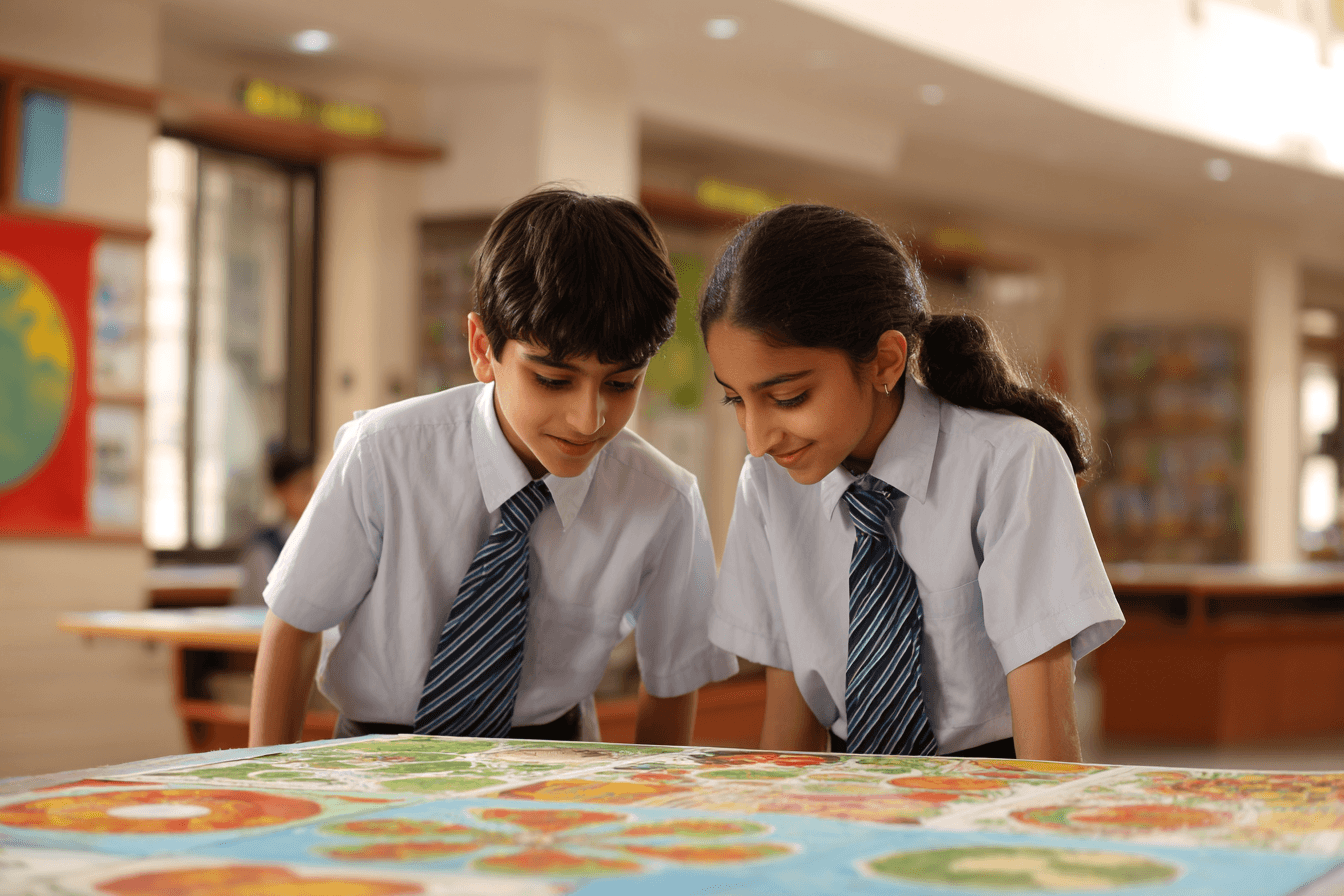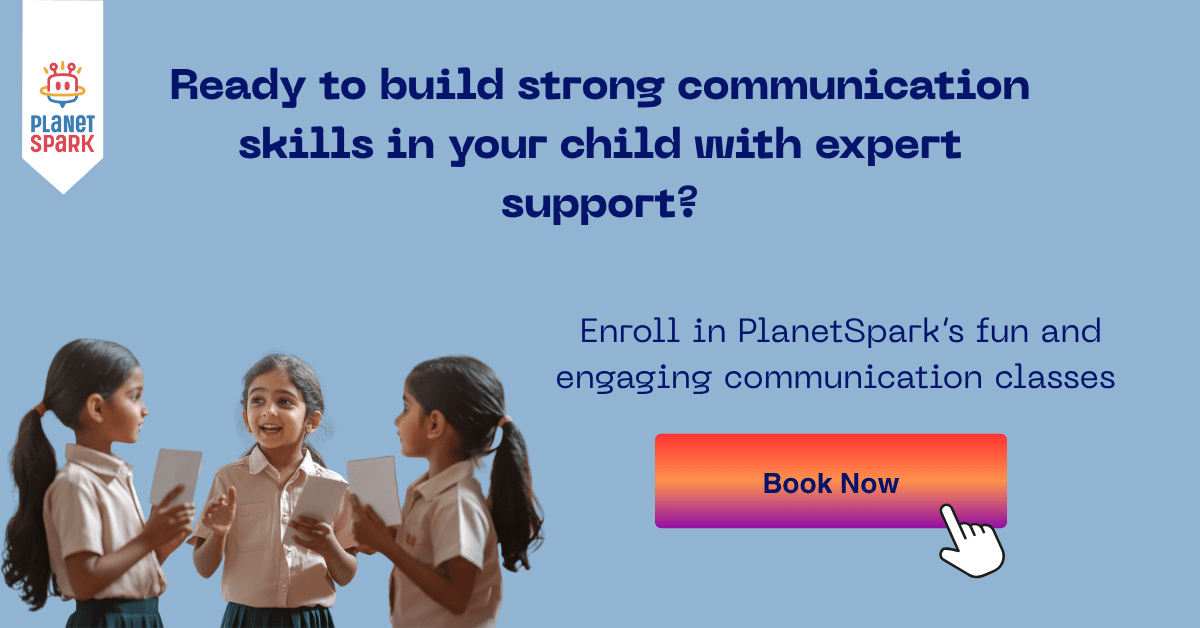4 Types of Communication Skills Explained in Detail

Table of Contents
Communication is a key life skill for every child. From classroom conversations to chats with friends, kids use different ways to express themselves. But many don’t realise there are 4 types of communication we all use daily.
Understanding these types helps children speak clearly, listen better, and build confidence. At PlanetSpark, we make this learning fun with expert-led, one-on-one sessions that improve how kids connect and express themselves.
Let’s take a closer look at the four types of communication and how mastering them can help your child grow.
What Are the 4 Types of Communication?
The four main types of communication are:
- Verbal Communication
- Non-Verbal Communication
- Written Communication
- Visual Communication
Each type plays a unique role in how we send and receive messages. Let’s understand them in detail.
1. Verbal Communication
What is Verbal Communication?
Verbal communication is the most direct and widely used form of communication among the 4 types of communication. It is one of the most essential forms of human interaction. It involves the use of spoken words to share thoughts, emotions, ideas, or information. Whether it’s a student answering a question in class or someone making a presentation at work, the way we speak shapes how we are understood by others.
At its heart, verbal communication is not only about what we say, but also how we say it. The tone, pitch, pace, and volume of our voice can add meaning or change the message entirely. A clear and confident speaker is more likely to engage listeners and create a lasting impression.
Common Types of Verbal Communication
There are several ways verbal communication is used in everyday life. Each setting serves a different purpose and helps develop specific skills.
Interpersonal communication: Happens between two individuals. It can be informal, like chatting with a friend, or more serious, like discussing something with a teacher or parent.
Group communication: Takes place in group discussions, teamwork, or classroom activities where multiple people share ideas and respond to one another.
Public speaking: Involves delivering information to a larger audience. This helps build confidence and clarity in thought. Examples include morning assemblies or giving a class presentation.
Digital verbal communication: Refers to speaking during phone calls, video meetings, or voice messages. It has become common in online classes and virtual workspaces.
What Makes Verbal Communication Effective?
Several elements work together to make verbal communication clear and impactful. These include:
Clear pronunciation: Speaking words clearly ensures that listeners understand the message without confusion.
Tone and emotion: The way something is said often matters more than the actual words. A kind tone can make a listener feel welcome, while a harsh tone might have the opposite effect.
Vocabulary: Having the right words to express thoughts makes communication smoother and more precise.
Listening skills: Good verbal communication also means being a good listener. Responding thoughtfully shows that you’ve understood and valued the conversation.

Discover how our expert coaches transform communication in kids.
Real-Life Examples of Verbal Communication
Verbal communication plays a role in many situations, both formal and informal.
- A child asking a parent for help with homework
- Students working together on a science project
- A teacher explaining a math concept in class
- A person giving a speech during a school event or function
Even casual conversations during lunchtime or asking a classmate a question during a group activity rely on this skill.
Why Verbal Communication Is Important
Being able to communicate effectively through speech helps in every part of life. Some of the key benefits include:
Improved academic performance: Children who speak confidently are more likely to ask questions, participate in discussions, and perform well in oral exams.
Better relationships: Clear communication builds stronger connections with friends, teachers, and family members.
Stronger leadership skills: Expressing ideas with clarity allows individuals to lead discussions and guide others.
Conflict resolution: Verbal communication helps people address misunderstandings or disagreements calmly and respectfully.
Over time, children who develop strong verbal skills find it easier to adjust in social and academic settings. It also lays the foundation for future success in job interviews, professional meetings, and team collaborations.
2. Non-Verbal Communication
What is Non-Verbal Communication?
Non-verbal communication is the silent yet powerful form of expression among the 4 types of communication. It is the silent language we use every day. It refers to all the ways we express ourselves without using words. This includes facial expressions, hand gestures, posture, eye contact, and even the distance we keep while talking to someone.
Often, non-verbal communication speaks louder than words. A warm smile, a firm handshake, or folded arms can all say something before a single word is spoken. It plays a major role in how messages are sent and received, often supporting or even replacing verbal messages.

What Does Non-Verbal Communication Include?
Non-verbal cues are used in many ways to enhance or modify communication. Here are the most common types:
- Facial expressions: Emotions such as happiness, sadness, anger, or surprise can be conveyed through facial movements. These expressions are often universal and understood across cultures.
- Gestures: Movements of the hands or arms, such as waving, pointing, or giving a thumbs up, help explain or emphasise what is being said.
- Posture and body language: Standing tall shows confidence, while slouching may signal boredom or disinterest. The way we carry ourselves often reveals our attitude.
- Eye contact: Looking someone in the eye while speaking shows attentiveness and sincerity. Avoiding eye contact might indicate nervousness or distraction.
- Proximity and space: How close we stand or sit to others can show comfort levels or respect. Being too close may seem aggressive, while too much distance can seem cold.
- Appearance: Clothing and grooming also communicate messages. Neat, appropriate attire often reflects respect for the setting or occasion.
The Role of Non-Verbal Communication in Daily Life
Non-verbal communication is constantly happening, even when we are unaware of it. It plays a significant role in both personal and professional settings.
- In schools, a teacher's nod of approval can motivate a student.
- During conversations, friends may express support through a pat on the back.
- In interviews, confident posture and steady eye contact often leave a positive impression.
- At home, parents can show love or concern through simple gestures or tone.
- It helps people understand the real emotions behind words and can offer clues about how someone is feeling.
Why Non-Verbal Communication Matters
Non-verbal communication complements spoken language and makes it more powerful. Some key benefits include:
- Enhancing understanding: Gestures and expressions clarify verbal messages, making them easier to interpret.
- Building trust: Honest body language, such as open posture and eye contact, helps build credibility and rapport.
- Supporting active listening: Nods, facial reactions, and leaning forward indicate that someone is paying attention.
- Expressing emotions: Sometimes, words fall short. A tear, smile, or hug may express feelings more clearly than sentences ever could.
This form of communication is especially useful in situations where language barriers exist or when verbal speech is limited, such as with young children or differently abled individuals.
From shy speakers to confident communicators.
See the PlanetSpark difference: Book a Demo!
3. Written Communication

What is Written Communication?
Among the 4 types of communication, written communication stands out for its precision, structure, and longevity. Whether we’re drafting a business email, jotting down classroom notes, or publishing a newspaper article, the written word helps us communicate ideas in a structured and retrievable way.
Written communication refers to the act of conveying messages through written symbols such as letters, emails, reports, texts, or even digital posts. It provides a tangible record of information, making it an essential form of communication in academic, professional, and legal contexts.
Unlike verbal or non-verbal communication, written messages can be edited, stored, and reviewed before being shared. This makes them more reliable when accuracy and clarity are important.
Importance in Everyday Life
In schools, written communication is used for essays, homework submissions, and teacher-parent notes. In professional environments, it includes documents like memos, reports, policies, and contracts. Even casual text messages and social media updates fall under this category.
Written communication is particularly useful when:
- Information needs to be documented for future reference
- The message must be delivered to a large audience across different locations
- Formality and professionalism are expected
Benefits of Written Communication
One of the biggest advantages is that it allows for careful planning. The sender has time to organize thoughts, proofread, and revise. This reduces misunderstandings and misinterpretations.
Another strength is its permanence. Unlike spoken words, written content doesn’t vanish after it's shared. It can be archived, retrieved, and re-read, offering accountability in both personal and professional settings.
For example, a school circular announcing exam dates, a formal job offer letter, or even a WhatsApp group message coordinating a weekend outing all rely on the written word to ensure clarity and consistency.
Real-Life Examples of Written Communication
- Educational Settings: Notes, essays, report cards, school announcements
- Professional Use: Emails, resumes, business reports, legal documents
- Everyday Life: Grocery lists, text messages, blogs, comments on social media
Each of these examples shows how written communication makes our lives more organised and efficient.
4. Visual Communication

What is Visual Communication?
Visual communication is the most immediate and universally understood among the 4 types of communication. It relies on images, colours, symbols, graphics, and visual cues to convey ideas or information. When crafted well, visual content can instantly capture attention and communicate meaning even across language barriers.
Visual communication is the use of visuals to send a message. This includes everything from road signs and pie charts to movies, emojis, and advertising posters. It is especially powerful in simplifying complex information and making it memorable.
Unlike verbal or written communication, visuals engage viewers quickly. A single infographic can explain a large data set. A logo can represent a company’s identity. A facial expression in a photograph can tell a story.
Everyday Use of Visual Communication
We use visual communication more than we realise. In classrooms, teachers use diagrams and charts to support their lessons. In the workplace, presentations with slides, graphs, and visuals help make reports more engaging and easier to understand.
At home or socially, we respond to memes, emojis, GIFs, or videos shared over messaging apps. Visuals allow people to express emotions, reinforce ideas, and grab attention within seconds.
Here are a few common examples:
- Infographics to summarise long-form content
- Traffic signs to provide quick safety instructions
- Maps and charts for directions or statistics
- Brand logos that create instant recognition
- Social media images that express thoughts or humour
Advantages of Visual Communication
Visuals are easier to remember. Research shows that people retain images better than text. This is why educational content, marketing materials, and even newspapers use visual aids.
They also transcend language. A no-smoking symbol or a red stop sign communicates effectively without needing words. This makes visual communication highly accessible and inclusive.
In fast-paced environments, visuals save time. Instead of reading a full report, a graph or pie chart can provide a summary at a glance.
Why Understanding the 4 Types of Communication Is Important
Each type of communication has its place and purpose. Some situations may require more than one type at a time. For example, a classroom lesson may involve verbal speech, written notes, visual slides, and body language. By understanding the strengths of each type, individuals can choose the best way to express their ideas, depending on the audience and goal.
| Type | Medium Used | Best For |
|---|---|---|
| Verbal | Spoken words | Immediate expression and dialogue |
| Non-verbal | Body language, gestures | Showing emotions and adding depth to speech |
| Written | Text and symbols | Record keeping and detailed communication |
| Visual | Images and visuals | Simplifying complex information and creating impact |
How the 4 Types of Communication Work Together
In real-world situations, communication is rarely one-dimensional. Most conversations or interactions use a combination of all four types. For example, when someone gives a presentation at work or school, they may speak verbally, gesture with their hands, share a written handout, and use slides or visuals on a screen. Each form enhances the message in a different way.
Let’s look at how this integration helps:
Verbal communication provides clarity and structure to what is being said.
Non-verbal communication adds emotion and sincerity to the words.
Written communication allows the message to be reviewed later or shared more broadly.
Visual communication supports learning through diagrams, symbols, or illustrations.
When used together, these communication types create a richer, more effective message that is easier for the listener or reader to understand, remember, and respond to.
Watch your child shine with improved communication skills.
The Role of Communication in Academic and Personal Success
Understanding and using different types of communication is especially helpful in education and personal development. Here’s how:
Improves Learning: Students who can read, write, speak, and present visually are better equipped to grasp new topics, ask questions, and perform well in exams and group projects.
Builds Confidence: Being skilled in all four forms allows individuals to adapt their communication style to different situations. This boosts self-assurance during public speaking, interviews, and team discussions.
Enhances Social Skills: Whether making friends, resolving conflicts, or expressing gratitude, effective communication helps build stronger relationships.
Prepares for the Future: In careers across business, education, technology, and arts, professionals need to write emails, give presentations, design materials, and collaborate with teams. Mastering all communication types prepares one for these demands.
How the 4 Types of Communication Work Together
The 4 types of communication: verbal, non-verbal, written, and visual, are most effective when they are used together. In everyday situations, we naturally combine these forms to make our messages clearer, more engaging, and easier to understand.
For instance, picture a teacher explaining a science concept. They speak to the class using clear language (verbal), use hand gestures and facial expressions to emphasise key points (non-verbal), provide printed notes (written), and display a diagram or video for better illustration (visual). This multi-layered approach helps students absorb information from different angles.
Here are a few real-life scenarios where these communication types work together:
- A business presentation that includes a spoken pitch, confident body language, a detailed report, and supporting visuals like charts.
- A classroom session that involves live explanations, chalkboard writing, and visual aids like slides.
- A social media post that uses a short caption, expressive emojis, and a powerful image to deliver a message quickly.
Each type contributes something unique:
- Verbal communication provides structure and clarity.
- Non-verbal communication adds tone, emotion, and emphasis.
- Written communication offers detailed documentation and reference.
- Visual communication grabs attention and supports better understanding.
When you combine all four types, the result is stronger, more memorable communication. Whether you are speaking to a group, teaching a class, or sharing content online, blending these methods ensures your message is well received.
Mastering the four types of communication is not just about speaking well. It helps build stronger relationships, improves collaboration, and increases your overall effectiveness as a communicator.
Help your child master all forms of communication.
Why the 4 Types of Communication Are Important for Growing Kids
Communication is one of the most essential life skills a child can develop. As kids grow, they need more than just the ability to speak. They must learn to express thoughts clearly, understand others, and respond appropriately in different situations. This is where the 4 types of communication: verbal, non-verbal, written, and visual play a key role.
Each form of communication supports a different area of a child’s development. Together, they shape how children interact with the world and prepare them for both academic and personal success.
Verbal Communication Builds Confidence
When children learn to express themselves clearly through words, they become more confident in social situations. Verbal skills help them:
- Participate actively in class discussions
- Ask questions when they need help
- Share their opinions and feelings without hesitation
These abilities encourage independence and better peer relationships.
Non-Verbal Communication Improves Emotional Intelligence
Non-verbal cues like facial expressions, body posture, and tone of voice teach kids to read between the lines. This helps them:
- Understand how others are feeling
- Show empathy and kindness
- Respond appropriately without always needing words
It builds strong emotional awareness, a skill that is essential in both friendships and future workplaces.
Written Communication Boosts Academic Success
As children progress through school, written communication becomes increasingly important. It allows them to:
- Organise their thoughts through essays and assignments
- Score better in exams by writing clearly and effectively
- Express creativity through stories, poems, and journals
Strong writing skills also help with digital communication like emails, texts, and online discussions.
Visual Communication Sparks Creativity and Quick Understanding
Kids often understand ideas better through visuals like charts, drawings, and symbols. Visual communication:
- Enhances memory and comprehension
- Makes learning more interactive and fun
- Encourages creative thinking and design skills
It is especially helpful for visual learners who grasp information faster with images than with words.

How PlanetSpark Helps Children Master All 4 Types of Communication
At PlanetSpark, we understand that communication is not limited to just speaking. That’s why our programs are designed to develop all 4 types of communication—verbal, non-verbal, written, and visual—through a structured and interactive curriculum.
Here's how PlanetSpark supports holistic communication growth:
1:1 Personal Trainers: Every child is paired with a certified communication coach who tailors sessions to suit their learning style and pace.
Live Speaking Practice: Through storytelling, debates, role-plays, and speech delivery, kids improve their verbal and non-verbal communication in real-time.
Creative Writing & Journaling: Children learn to express ideas clearly with structured writing exercises, boosting their written skills.
SparkX Video Analysis: Our AI-powered feedback tool helps students analyse their facial expressions, tone, and gestures for stronger non-verbal presence.
Visual Learning Tools: We use infographics, mind maps, and visual prompts to make complex concepts easier to grasp and remember.
Gamified Learning: Fun activities and challenges keep students engaged while strengthening each communication type.
With regular progress reports, parent-teacher meetings, and expert guidance, PlanetSpark ensures your child becomes a confident and complete communicator ready for the world.
Conclusion
The ability to communicate effectively is one of the most valuable gifts we can give children. Each of the 4 types of communication: verbal, non-verbal, written, and visual, plays a distinct and essential role in how they learn, interact, and grow.
By helping children understand and use all four forms, we empower them to succeed not just in school, but in life. Whether it's delivering a presentation, writing a story, interpreting emotions, or creating impactful visuals, strong communication leads to better relationships, higher self-esteem, and greater academic performance.
Start early. Build strong. And let your child’s voice, expression, and creativity shine in every way.
Frequently Asked Questions
Q1. What are the 4 types of communication?
The four main types of communication are verbal (spoken words), non-verbal (body language, facial expressions, tone), written (texts, emails, essays), and visual (images, charts, symbols).
Q2. Why is it important for children to learn all four types?
Each type supports different aspects of development: verbal builds confidence, non-verbal builds empathy, written improves academics, and visual enhances understanding. Together, they help children communicate better in every situation.
Q3. Can PlanetSpark help my child improve all communication types?
Yes. PlanetSpark offers personalised online classes that focus on verbal, non-verbal, written, and visual communication using live sessions, AI tools, and structured activities.
Q4. What age group are PlanetSpark classes suitable for?
PlanetSpark programs are designed for children aged 4 to 16, with age-appropriate content and methods tailored for each stage.
Q5. How do I know if my child is progressing?
We provide regular progress reports, personalised feedback, and one-on-one PTMs to keep you informed and involved in your child’s communication journey.
Q6. Is creative communication also included in the curriculum?
Yes. Activities like storytelling, poetry, visual prompts, and presentations are part of our curriculum to help kids express ideas creatively and effectively.
Q7. Are these skills helpful beyond school?
Absolutely. Communication is a life skill. It helps kids succeed in interviews, leadership roles, social interactions, and future workplaces.
Personalized Communication Report
Record a video to get a AI generated personalized communication report for your child

Hi There, want to try these
tips for your child with
LIVE with our expert coach?
Let's check your child's
English fluency
